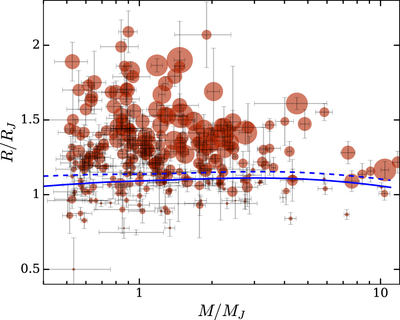Image Details

Caption: Figure 1.
Radius and mass (relative to Jupiter) of giant planets. The data are taken from exoplanet.eu (Schneider et al. 2011) and the NASA exoplanet archive (Akeson et al. 2013). We only chose exoplanets whose relative radius and mass uncertainties are below 50%. The area of the data points scale as a function of the stellar heat flux at the planetary orbit. The smallest and largest values (in ﹩\mathrm{erg}\,{{\rm{s}}}^{-1}\,{\mathrm{cm}}^{-2}﹩) of incident stellar flux are about 106 and 1010. The blue solid and broken curves represent the radius predictions for solar-ratio H/He planets (no metals) of ages 5 and 1 Gyr and an incident stellar flux of 106 (Thorngren & Fortney 2017).
Copyright and Terms & Conditions
© 2017. The American Astronomical Society. All rights reserved.




